Anatomy of a Perfect Execution: How SMC Traders Trade with Precision
2025-10-27 09:26:59
There’s a difference between taking trades and taking command.
The former reacts to the market; the latter reads it like a map.
Every elite trader knows that perfect execution isn’t about catching every move - it’s about entering the move that aligns with logic, structure, and timing. That calm, deliberate precision doesn’t come from intuition; it comes from a process rooted in why Smart Money Concepts work.
The anatomy of a perfect execution has three essential layers: displacement, retracement, and confirmation.
Master them, and hesitation disappears.

The anatomy of a perfect execution has three essential layers: displacement, retracement, and confirmation.
Master them, and hesitation disappears.
The Displacement: Reading the Market’s Intent
Every story of a great trade begins with movement - not random volatility, but controlled aggression.
That’s displacement - the market’s heartbeat.
You’ll know it when you see it: strong-bodied candles, minimal wicks, and structure-breaking force or coming from a certain liquidity level. It’s the signature of institutions - when money flows in one direction with conviction, leaving behind an imbalance called a Fair Value Gap (FVG) for price to later rebalance.
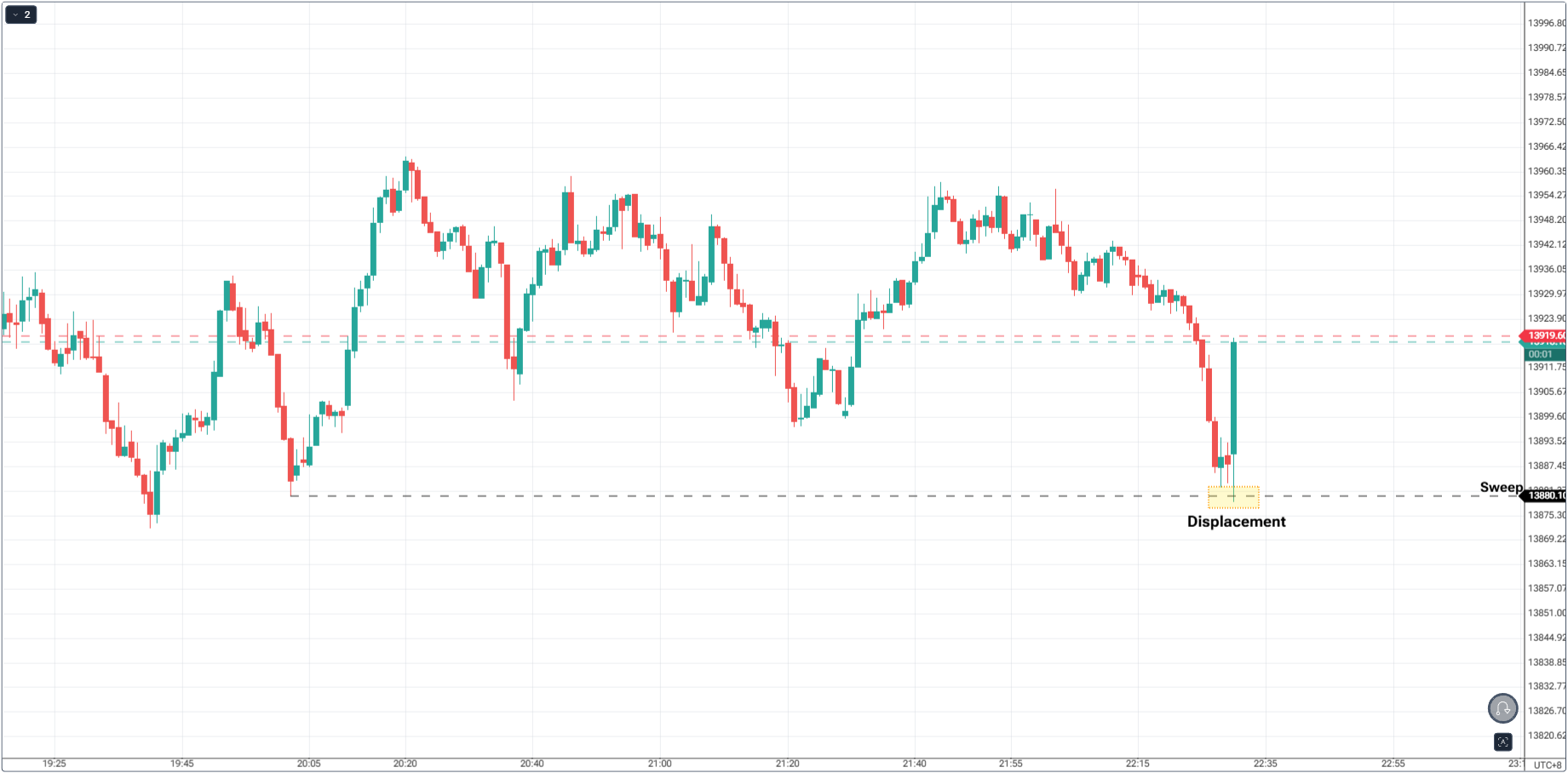
Displacement reveals who’s in control:
- Bullish displacement signals smart money accumulation and cleared liquidity above.
- Bearish displacement signals distribution and liquidity swept below.
But here’s the nuance most traders miss: displacement only matters when it aligns with the higher timeframe trend. If your H1 or M15 chart shows a bullish displacement but the Daily trend remains strongly bearish, that lower timeframe surge might not be smart money entering - it could be liquidity engineering. The fastest way to filter this is with deliberate multi-timeframe analysis.
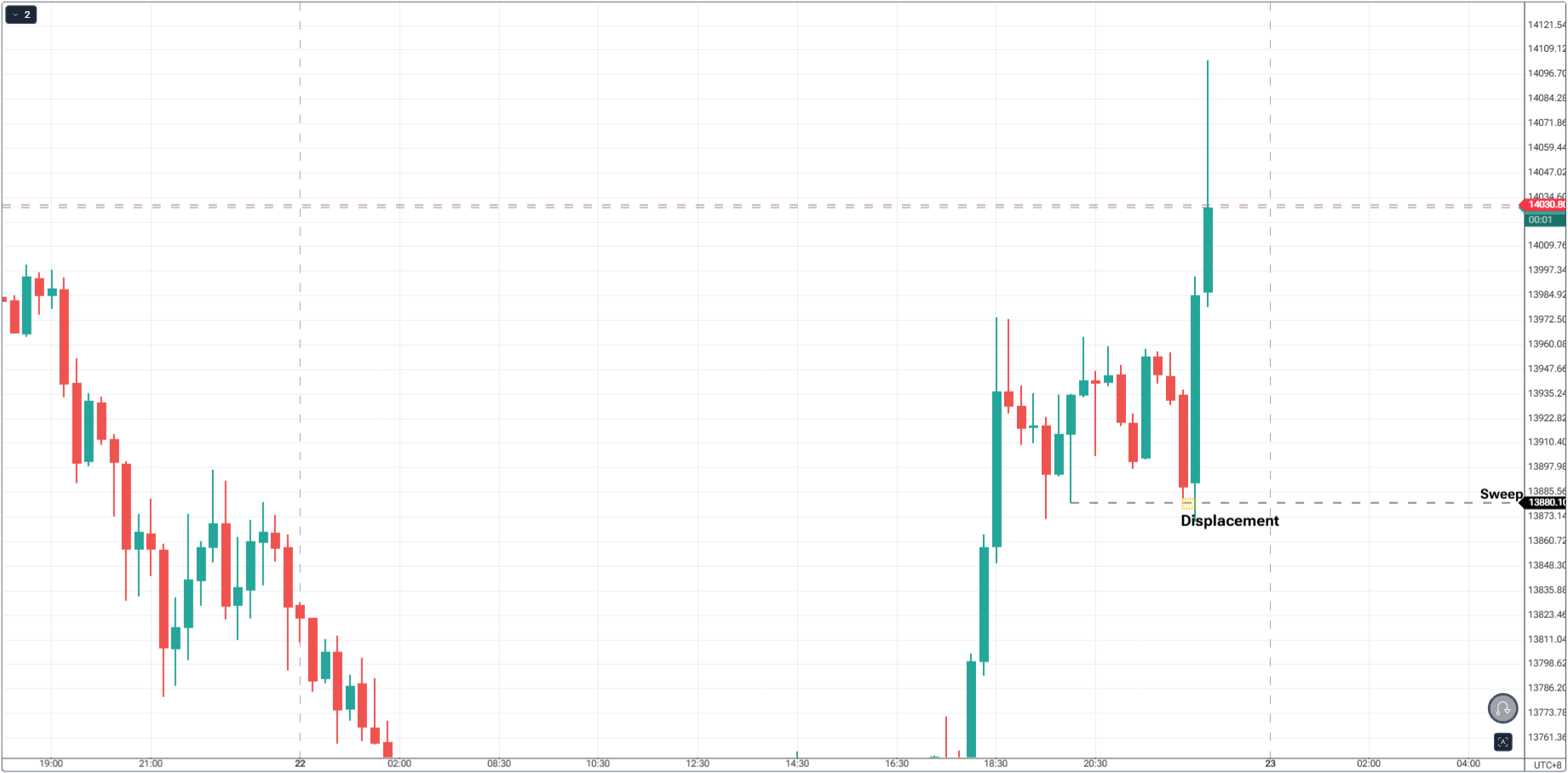
If your H1 or M15 chart shows a bullish displacement but the Daily trend remains strongly bearish, that lower timeframe surge might not be smart money entering - it could be liquidity engineering.
In other words, it’s not a trend shift - it’s a trap.
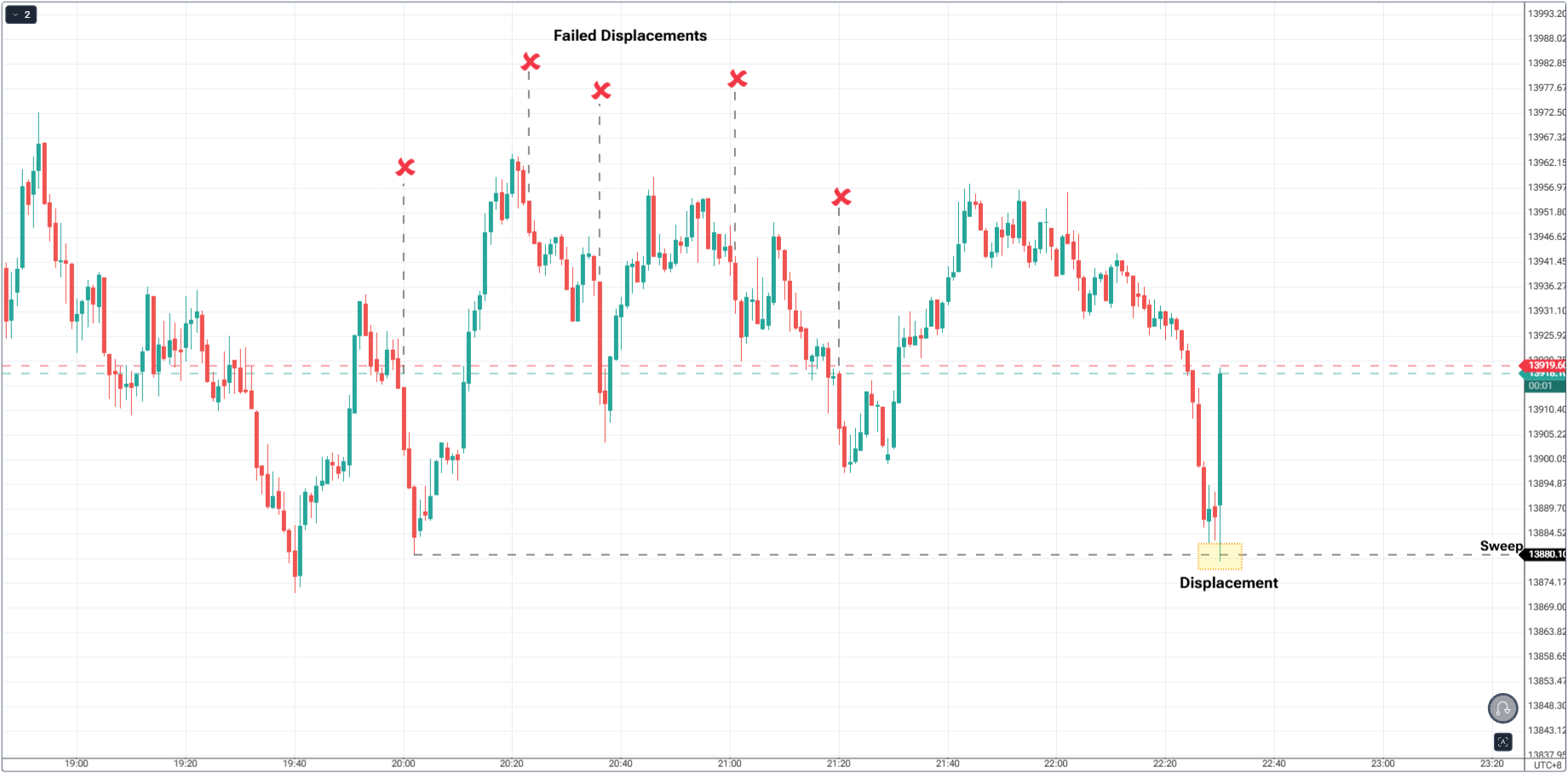
This is where multi-timeframe logic separates the elite from the impulsive.
- When displacement aligns with the Daily bias, it’s momentum worth following.
- When it opposes it, treat it as a potential fakeout - a sweep before continuation.
So before acting on any lower timeframe impulse, zoom out. If the daily flow contradicts your entry direction, you’re probably trading against the tide - and the market has a way of humbling those who swim upstream. To read that tide with clarity, frame the day using session structure like the New York session playbook.
The Retracement: Where Patience Meets Preparation
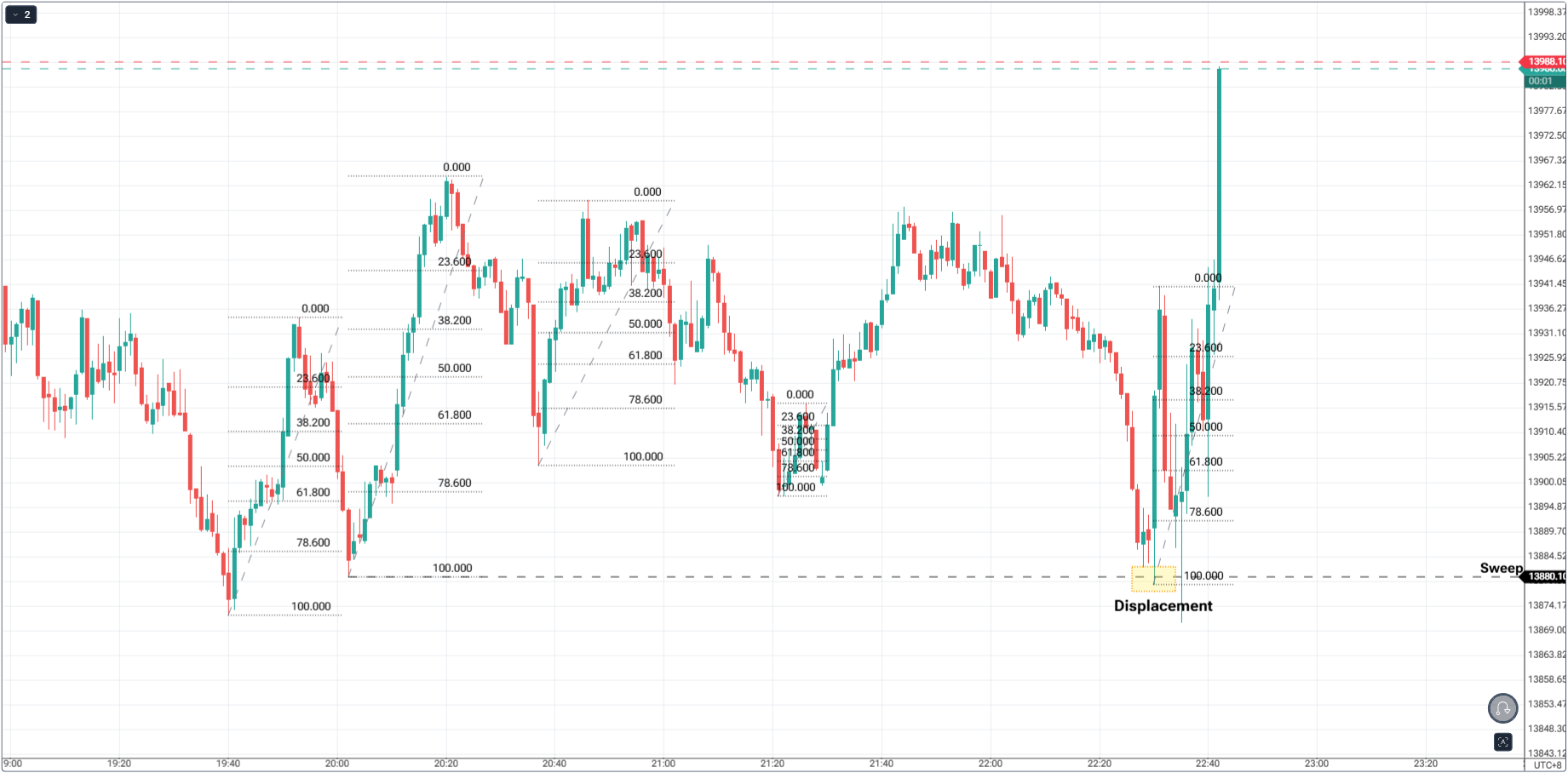
After every surge comes stillness - a pause that separates impulse from intention.
That’s the retracement.
To the impatient trader, it feels like opportunity slipping away.
To the disciplined one, it’s the setup forming.
Retracements restore balance after displacement. They pull price back into value zones - often overlapping with discount/premium levels around 50%–61.8%, which you can plan using this Fibonacci targets & stops guide. Confluence with prior swing liquidity and well-defined price action at key levels turns patience into probability.
This is where discipline lives.
You’re not chasing; you’re waiting. You’re letting the market come to you.
Retracement isn’t weakness - it’s efficiency. It’s the market inhaling before the next move.
The Confirmation: Logic Becomes Action
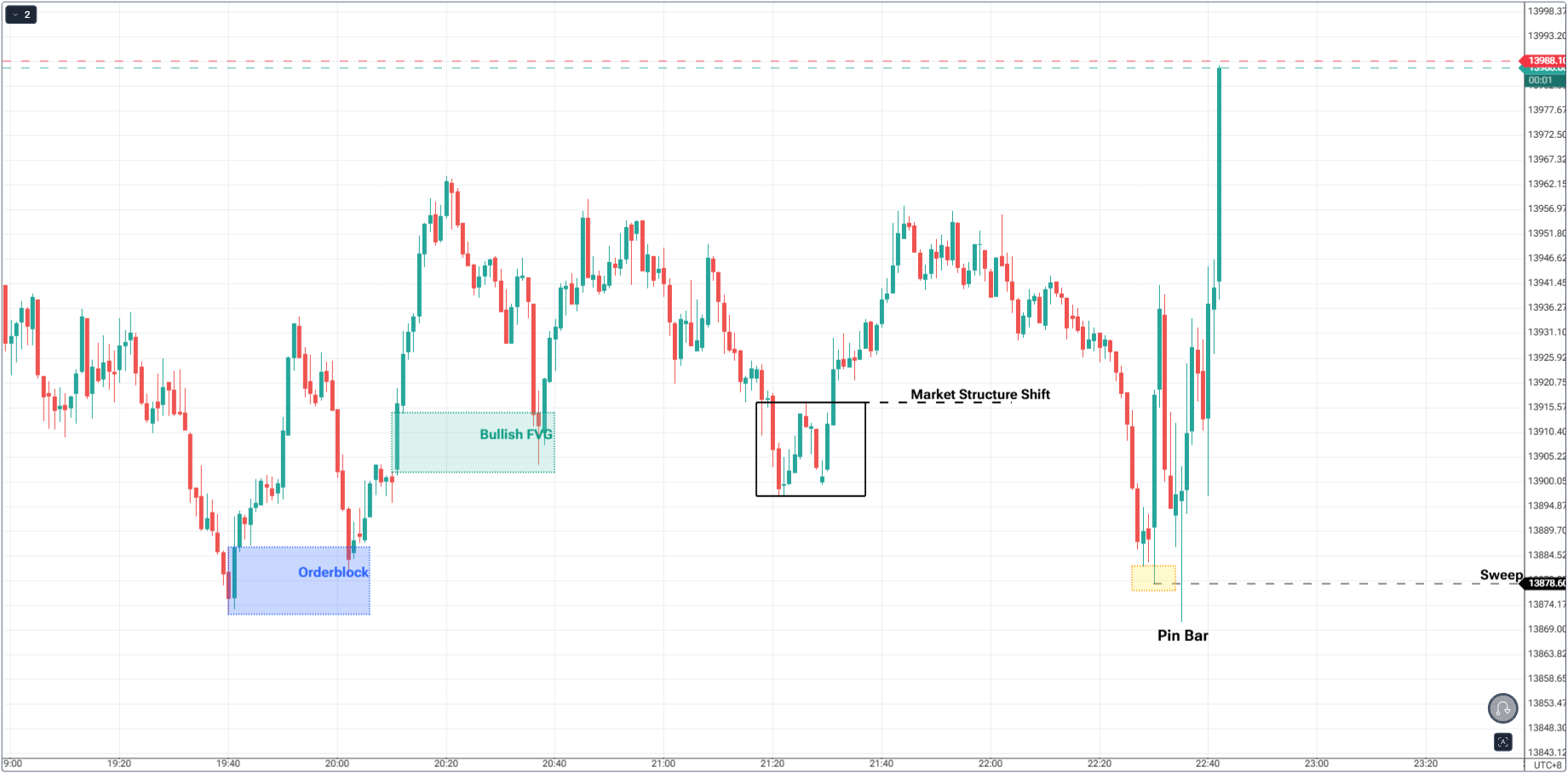
Here’s where theory meets timing.
Once price returns to your area of interest, don’t rush.
Let the market confirm its intent.
Elite traders wait for evidence - not emotion. That proof often shows up as:
- Liquidity sweep - the market takes out stops then rejects sharply, a behavior unpacked in this piece on liquidity sweeps and trading the zones.
- Market Structure Shift (MSS) - control flips as a minor high or low breaks, best seen when HTF bias and LTF structure are in sync (again, see multi-timeframe confluence).
- Internal FVG (iFVG) - a mini imbalance marking where smart money re-enters after the shift.
- Order Blocks (OB): Last opposing candle before the big move.
- Strong Candles: A good strong candle could signal a pause on retracement and continuation on the break.
Session timing matters. A sweep into your zone just before the US cash open often sets the stage for a clean drive, which is why an indices open plan like this SMC scalp-at-the-open framework is so valuable.
The Execution: Discipline in Motion
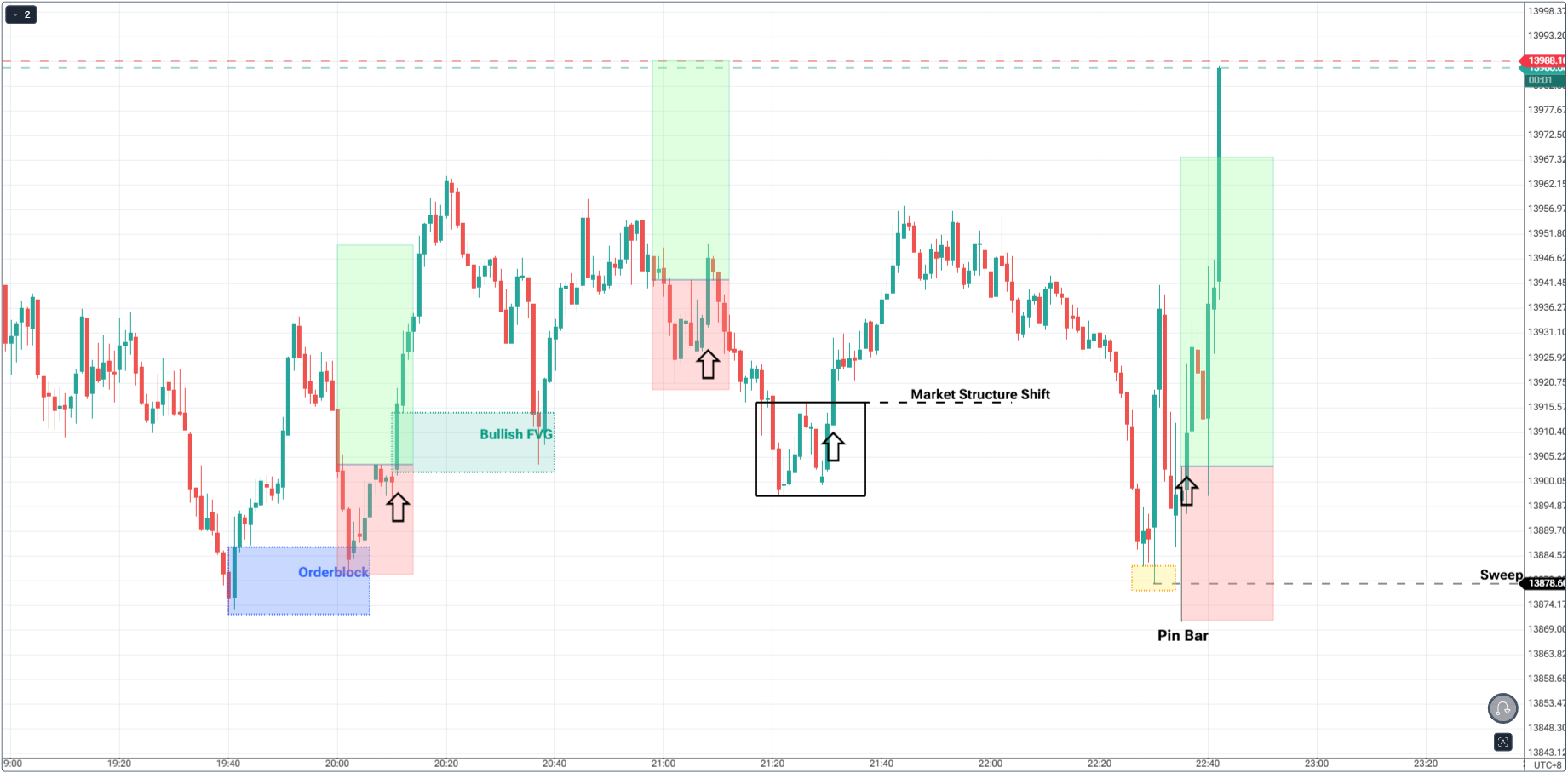
Execution isn’t excitement - it’s precision. When you’ve defined your rules, you no longer guess. You act.
Here’s the elite approach:
- Entry: Inside the confirmation zone (mid-FVG or candle close).
- Stop Loss: Just beyond structural invalidation.
- Target: Next liquidity pool or 2R–3R range objective.
The math that protects you sits inside robust risk management - from position sizing to stop placement to take-profit logic.
The Reflection: Where Perfection Is Built

Every flawless execution you see online came from years of flawed ones.
The real mastery happens after the trade - in reflection.
Ask yourself after every setup:
- Did I trade after displacement or before it?
- Did I let retracement form or chase momentum?
- Did I wait for confirmation or act on impulse?
- Did I check higher timeframe alignment before entering?
Codify those answers in a structured journal so feedback compounds - this guide on the trading journal and reflection shows what to track and why.
Real-Life Analogy: The Sniper’s Rhythm
Picture a sniper before the shot:
- Displacement is spotting the target’s movement - understanding direction.
- Retracement is the moment of stillness - holding breath, aligning scope.
- Confirmation is when the heartbeat syncs with the trigger.
- Execution is the quiet exhale - no rush, no tremor, just flow.
Every step builds on the previous.
Rush one, and you miss all.
And if your scope isn’t aligned with the wind direction - your higher timeframe - you’ll miss, even with perfect form.
Final Thoughts: The Discipline Behind Precision
Perfect execution isn’t about being right - it’s about being aligned. The trader who trades with the tide doesn’t need to force precision; it flows naturally. The one who trades against it keeps mistaking traps for trends.
In trading, patience is your entry fee, and alignment is your edge. Once you understand that displacement without trend context is deception, your confidence will shift from guessing to knowing. If you want a simple mindset frame to keep emotion out of your clicks, start with how to think like a price action trader.
Perfection isn’t found in prediction - it’s earned through patience, process, and perspective.
FAQs
1. How can I tell if displacement is real?
True displacement breaks structure with large-bodied candles and leaves imbalance behind - but always validate it against the higher timeframe. Misaligned displacement often signals a fakeout. For a deeper structural lens, revisit multi-timeframe confluence.
2. Which timeframe gives the best clarity?
Use higher timeframes (H1–H4) to spot displacement and directional bias, then refine entries using lower timeframes (M5–M1) for confirmation. Anchor timing with a session framework like the New York session guide.
3. Why do I still hesitate even after confirmation?
Because your plan isn’t mechanical yet. Define entry, stop, and target before the setup forms - execution should feel procedural, not emotional. Hardwire the process with a clear risk plan and position sizing.
4. Can every FVG be traded?
No. Trade only those aligned with higher-timeframe displacement and structure. Context validates the setup, not the candle pattern - review the core logic behind FVG footprints.
Start Practicing with Confidence - Risk-Free!
- Trade forex, indices, gold, and more
- Access ACY, MT4, MT5, & Copy Trading Platforms
- Practice with zero risk
It’s time to go from theory to execution - risk-free.
Create an Account. Start Your Free Demo!
Check Out My Contents:
Strategies That You Can Use
Looking for step-by-step approaches you can plug straight into the charts? Start here:
- How To Trade & Scalp Indices at the Open Using Smart Money Concepts (SMC)
- How to Trade Breakouts Effectively in Day Trading with Smart Money Concepts
- Complete Step-by-Step Guide to Day Trading Gold (XAU/USD) with Smart Money Concepts (SMC)
- The Power of Multi-Timeframe Analysis in Smart Money Concepts (SMC)
- Forex Trading Strategy for Beginners
- Mastering Candlestick Pattern Analysis with the SMC Strategy for Day Trading
- How to Use Fibonacci to Set Targets & Stops (Complete Guide)
- RSI Divergence Trading Strategy for Gold: How to Identify and Trade Trend Reversals
- Stochastics Trading Secrets: How to Time Entries in Trending Markets using Stochastics
- Gold Trading Stochastics Strategy: How to Trade Gold with 2R - 3R Targets
- RSI Hidden Divergence Explained: How to Spot Trend Continuations Like a Pro
- Moving Averages Trading Strategy Playbook
- Mastering Fibonacci Trading Psychology - Trusting the Levels, Managing the Mind
- Mastering Price Action at Key Levels - How to Spot, Trade, and Win at the Most Crucial Zones
- Mastering Retests: How to Enter with Confirmation After a Breakout
Indicators / Tools for Trading
Sharpen your edge with proven tools and frameworks:
- The Ultimate Guide to Risk Management in Trading - A Complete Compilation for 2025
- Moving Averages Trading Strategy Playbook
- How to Think Like a Price Action Trader
- Mastering Fibonacci Trading Psychology - Trusting the Levels, Managing the Mind
How To Trade News
News moves markets fast. Learn how to keep pace with SMC-based playbooks:
- Why Smart Money Concepts Work in News-Driven Markets - CPI, NFP, and More
- How to Trade NFP Using Smart Money Concepts (SMC) - A Proven Strategy for Forex Traders
- How to Trade CPI Like Smart Money - A Step-by-Step Guide Using SMC
Learn How to Trade US Indices
From NASDAQ opens to DAX trends, here’s how to approach indices like a pro:
- How to Start Trading Indices and Get into the Stock Market with Low Capital (2025 Guide)
- Best Indices to Trade for Day Traders | NASDAQ, S&P 500, DAX + Best Times to Trade Them
- How To Trade & Scalp Indices at the Open Using Smart Money Concepts (SMC)
- NAS100 - How to Trade the Nasdaq Like a Pro (Smart Money Edition)
How to Start Trading Gold
Gold remains one of the most traded assets - here’s how to approach it with confidence:
- How to Swing Trade Gold (XAU/USD) Using Smart Money Concepts: A Simple Guide for Traders
- Complete Step-by-Step Guide to Day Trading Gold (XAU/USD) with Smart Money Concepts (SMC)
- The Ultimate Guide to Backtesting and Trading Gold (XAU/USD) Using Smart Money Concepts (SMC)
- Why Gold Remains the Ultimate Security in a Shifting World
- How to Exit & Take Profits in Trading Gold Like a Pro: Using RSI, Range Breakdowns, and MAs as Your Confluence
How to Trade Japanese Candlesticks
Candlesticks are the building blocks of price action. Master the most powerful ones:
- Mastering the Top Japanese Candlesticks: The Top 5 Candlesticks To Trade + Top SMC Candlestick Pattern
- How to Trade Candlestick Patterns with High Probability: A Complete Guide for Beginners
- The Top Japanese Candlestick Guide: What is an Engulfing Pattern and How to Trade It?
- Piercing Pattern Candlestick Explained: How to Trade It - Step-By-Step Guide
- Morning & Evening Star Candlestick Patterns - How to Trade Market Reversals with Confidence
How to Start Day Trading
Ready to go intraday? Here’s how to build consistency step by step:
- 5 Steps to Start Day Trading: A Strategic Guide for Beginners
- 8 Steps How to Start Forex Day Trading in 2025: A Beginner’s Step-by-Step Guide
- 3 Steps to Build a Trading Routine for Consistency and Discipline - Day Trading Edition
- The Ultimate Guide to Understanding Market Trends and Price Action
- Trading with Momentum: The Best Trading Session to Trade Forex, Gold and Indices
Swing Trading 101
- Introduction to Swing Trading
- The Market Basics for Swing Trading
- Core Principles of Swing Trading
- The Technical Foundations Every Swing Trader Must Master
- Swing Trader’s Toolkit: Multi-Timeframe & Institutional Confluence
- The Psychology of Risk Management in Swing Trading
- Swing Trading Concepts To Know In Trading with Smart Money Concepts
- Becoming a Consistent Swing Trader: Trading Structure & Scaling Strategy
Learn how to navigate yourself in times of turmoil
Markets swing between calm and chaos. Learn to read risk-on vs risk-off like a pro:
- How to Identify Risk-On and Risk-Off Market Sentiment: A Complete Trader’s Guide
- How to Trade Risk-On and Risk-Off Sentiment - With Technical Confirmation
- The Ultimate Guide to Understanding Market Trends and Price Action
- Metals in Risk-On and Risk-Off Environments: How Sentiment Moves Gold and Commodities
Want to learn how to trade like the Smart Money?
Step inside the playbook of institutional traders with SMC concepts explained:
- Why Smart Money Concepts Work: The Truth Behind Liquidity and Price Action
- Mastering the Market with Smart Money Concepts: 5 Strategic Approaches
- Understanding Liquidity Sweep: How Smart Money Trades Liquidity Zones in Forex, Gold, US Indices
- The SMC Playbook Series Part 1: What Moves the Markets? Key Drivers Behind Forex, Gold & Stock Indices
- The SMC Playbook Series Part 2: How to Spot Liquidity Pools in Trading - Internal vs External Liquidity Explained
- Fair Value Gaps Explained: How Smart Money Leaves Footprints in the Market
- Accumulation, Manipulation, Distribution: The Hidden Cycle That Runs Every Market
- Institutional Order Flow - Reading the Market Through the Eyes of the Big Players
- London Session Trading Secrets: How Smart Money Sets the High & Low of the Day
- Mastering the New York Session - Smart Money Concepts Guide
Master the World’s Most Popular Forex Pairs
Forex pairs aren’t created equal - some are stable, some are volatile, others tied to commodities or sessions.
- The Top 5 All-Time Best Forex Pairs to Trade
- Top Forex Pairs Beyond the Big Five
- EUR/USD: The King of Forex
- USD/JPY: The Fast Mover
- GBP/USD: The Volatile Cable
- AUD/USD: The Commodity Currency
- USD/CAD: The Oil-Backed Pair
- GBP/JPY: How to Trade The Beast
- Asian & London Session Secrets
- Mastering the New York Session
Metals Trading
- Metals Trading: Why Gold and Metals Are Rising Again
- Silver Trading: The Underdog with Dual Identity
- Gold vs Silver: Institutional Demand Breakdown Explained
- Platinum & Palladium: The Quiet Power Duo of Industrial Metals
- How to Trade Metals with SMC and Fundamentals - Gold Trading Strategy
- Future of Metals Market: Gold Forecast 2026 & Long-Term Commodities Outlook
Stop Hunting 101
If you’ve ever been stopped out right before the market reverses - this is why:
- Stop Hunting 101: How Swing Highs and Lows Become Liquidity Traps
- Outsmarting Stop Hunts: The Psychology Behind the Trap
- How to Lessen Risk From Stop Hunts in Trading
- How Stop Hunts Trigger Revenge Trading - Breaking the Pain Cycle
- How to Accept Stop Hunts Without Losing Discipline - Shifting From Frustration to Focus
Trading Psychology
Mindset is the deciding factor between growth and blowups. Explore these essentials:
- The Mental Game of Execution - Debunking the Common Trading Psychology
- Managing Trading Losses: Why You Can Be Wrong and Still Win Big in Trading
- The Hidden Threat in Trading: How Performance Anxiety Sabotages Your Edge
- Why 90% of Retail Traders Fail Even with Profitable Trading Strategies
- Top 10 Habits Profitable Traders Follow Daily to Stay Consistent
- Top 10 Trading Rules of the Most Successful Traders
- Top 10 Ways to Prevent Emotional Trading and Stay Disciplined in the Markets
- Why Most Traders Fail - Trading Psychology & The Hidden Mental Game
- Emotional Awareness in Trading - Naming Your Triggers
- Discipline vs. Impulse in Trading - Step-by Step Guide How to Build Control
- Trading Journal & Reflection - The Trader’s Mirror
- Overcoming FOMO & Revenge Trading in Forex - Why Patience Pays
- Risk of Ruin in Trading - Respect the Math of Survival
- Identity-Based Trading: Become Your Trading System for Consistency
- Trading Psychology: Aligning Emotions with Your System
- Mastering Fear in Trading: Turn Doubt into a Protective Signal
- Mastering Greed in Trading: Turn Ambition into Controlled Growth
- Mastering Boredom in Trading: From Restless Clicking to Patient Precision
- Mastering Doubt in Trading: Building Confidence Through Backtesting and Pattern Recognition
- Mastering Impatience in Trading: Turn Patience Into Profit
- Mastering Frustration in Trading: Turning Losses Into Lessons
- Mastering Hope in Trading: Replacing Denial With Discipline
- When to Quit on Trading - Read This!
- The Math of Compounding in Trading
- Why Daily Wins Matter More Than Big Wins
- Scaling in Trading: When & How to Increase Lot Sizes
- Why Patience in Trading Fuels the Compounding Growth
- Step-by-Step Guide on How to Manage Losses for Compounding Growth
- The Daily Habits of Profitable Traders: Building Your Compounding Routine
- Trading Edge: Definition, Misconceptions & Casino Analogy
- Finding Your Edge: From Chaos to Clarity
- Proving Your Edge: Backtesting Without Bias
- Forward Testing in Trading: How to Prove Your Edge Live
- Measuring Your Edge: Metrics That Matter
- Refining Your Edge: Iteration Without Overfitting
- The EDGE Framework: Knowing When and How to Evolve as a Trader
- Scaling Your Edge: From Small Account to Consistency
Market Drivers
- Central Banks and Interest Rates: How They Move Your Trades
- Inflation & Economic Data: CPI Trading Strategy and PPI Indicator Guide
- Geopolitical Risks & Safe Havens in Trading (Gold, USD, JPY, CHF)
- Jobs, Growth & Recession Fears: NFP, GDP & Unemployment in Trading
- Commodities & Global Trade: Oil, Gold, and Forex Explained
- Market Correlations & Intermarket Analysis for Traders
Risk Management
The real edge in trading isn’t strategy - it’s how you protect your capital:
- Mastering Risk Management: Stop Loss, Take Profit, and Position Sizing
- Why Risk Management Is the Only Edge That Lasts
- How Much Should You Risk per Trade? (1%, 2%, or Less?)
- The Ultimate Risk Management Plan for Prop Firm Traders - Updated 2025
- Mastering Position Sizing: Automate or Calculate Your Risk Like a Pro
- Martingale Strategy in Trading: Compounding Power or Double-Edged Sword?
- How to Add to Winners Using Cost Averaging and Martingale Principle with Price Confirmation
Suggested Learning Path
If you’re not sure where to start, follow this roadmap:
- Start with Trading Psychology → Build the mindset first.
- Move into Risk Management → Learn how to protect capital.
- Explore Strategies & Tools → Candlesticks, Fibonacci, MAs, Indicators.
- Apply to Assets → Gold, Indices, Forex sessions.
- Advance to Smart Money Concepts (SMC) → Learn how institutions trade.
- Specialize → Stop Hunts, News Trading, Turmoil Navigation.
This way, you’ll grow from foundation → application → mastery, instead of jumping around randomly.
Follow me for more daily market insights!
Jasper Osita - LinkedIn - FXStreet - YouTube
This content may have been written by a third party. ACY makes no representation or warranty and assumes no liability as to the accuracy or completeness of the information provided, nor any loss arising from any investment based on a recommendation, forecast or other information supplies by any third-party. This content is information only, and does not constitute financial, investment or other advice on which you can rely.
Try These Next
4 Powerful Tactics to Overcome the Most Costly Forex Mistakes
How to Master MT4 & MT5 - Tips and Tricks for Traders
The Importance of Fundamental Analysis in Forex Trading
Forex Leverage Explained: Mastering Forex Leverage in Trading & Controlling Margin
The Importance of Liquidity in Forex: A Beginner's Guide
Close All Metatrader Script: Maximise Your Trading Efficiency and Reduce Stress
Best Currency Pairs To Trade in 2025
Forex Trading Hours: Finding the Best Times to Trade FX
MetaTrader Expert Advisor - The Benefits of Algorithmic Trading and Forex EAs
Top 5 Candlestick Trading Formations Every Trader Must Know















